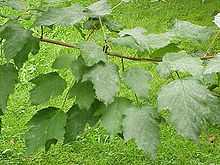Acer tataricum
| Acer tataricum | |
|---|---|
 | |
| Foliage and fruit | |
| Scientific classification | |
| Kingdom: | Plantae |
| (unranked): | Angiosperms |
| (unranked): | Eudicots |
| (unranked): | Rosids |
| Order: | Sapindales |
| Family: | Sapindaceae |
| Genus: | Acer |
| Species: | A. tataricum |
| Binomial name | |
| Acer tataricum L. | |

Acer tataricum (Tatar Maple or Tatarian Maple) is a species of maple native to central and southeastern Europe and southwestern Asia, from Austria east to southwestern Russia and the Caucasus, and south to Turkey. The species is named after the Tatar peoples of southern Russia; the tree's name is similarly commonly also spelled "Tartar" in English.[1][2]

It is a deciduous spreading shrub or small tree growing to 4–12 metres (13–39 ft) tall, with a short trunk up to 20–50 centimetres (7.9–19.7 in) diameter and slender branches. The bark is thin, pale brown, and smooth at first but becoming shallowly fissured on old plants. The leaves are opposite and simple, broadly ovate, 4.5–10 centimetres (1.8–3.9 in) long and 3–7 centimetres (1.2–2.8 in) broad, unlobed or with three or five shallow lobes, and matte green above; the leaf margin is coarsely and irregularly toothed; the leaf petiole is slender, often pink-tinged, 2–5 centimetres (0.79–1.97 in) long. The flowers are whitish-green, 5–8 millimetres (0.20–0.31 in) diameter, produced in spreading panicles in spring as the leaves open. The fruit is a paired reddish samara, 10–12 millimetres (0.39–0.47 in) long with a 2–3 centimetres (0.79–1.18 in) wing, maturing in late summer to early autumn.[1][2]
It is related to Acer ginnala (Amur Maple) from northeastern Asia; this is treated as a subspecies of Tatar Maple (Acer tataricum subsp. ginnala) by some botanists. They differ conspicuously in the glossy, deeply lobed leaves of A. ginnala, compared to the matte, unlobed or only shallowly lobed leaves of A. tataricum.[1]
Cultivation and uses
Tatar Maple is occasionally grown as an ornamental plant in gardens throughout Europe and also in North America. In Russia, it is valued in farmland shelterbelts.[2] It is locally naturalised in eastern North America.[1][3]
References
- ↑ 1.0 1.1 1.2 1.3 Rushforth, K. (1999). Trees of Britain and Europe. Collins. ISBN 0-00-220013-9.
- ↑ 2.0 2.1 2.2 Ecosystema: Acer tataricum (in Russian; google translation)
- ↑ "Acer tataricum". USDA Plant Profile. Retrieved October 9, 2007.
| Wikimedia Commons has media related to Acer tataricum. |